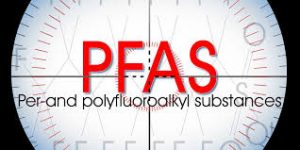Per- and polyfluoroalkyl substances : New Study

Researchers recently discovered nearly 20 species of bacteria capable of breaking down Per- and polyfluoroalkyl substances (PFAS).
- PFAS, also known as the Forever Chemicals, are a large chemical family of over 4,700 highly persistent, toxic, man-made, hazardous chemicals.
- They have been used in consumer products around the world since about the 1950s.
- They are ingredients in various everyday products. For example, PFAS are used to keep food from sticking to packaging or cookware, make clothes and carpets resistant to stains, and create firefighting foam that is more effective.
- PFAS molecules have a chain of linked carbon and fluorine atoms. Because the carbon-fluorine bond is one of the strongest, these chemicals do not degrade easily in the environment.
- Human exposure to PFAS is widespread but variable by geography and occupation.
- PFAS are used in the aerospace, automotive, construction, and electronics industries. Over time, PFAS may leak into the soil, water, and air.
- People are most likely exposed to these chemicals by consuming PFAS-contaminated water or food, using products made with PFAS, or breathing air containing PFAS.
- Because PFAS breaks down slowly, if at all, people and animals are repeatedly exposed to them, and blood levels of some PFAS can build up over time.
- Impacts of PFAS on Human Health: A variety of health risks that are attributed to PFAS exposure, including decreased fertility, developmental effects in children, interference with body hormones, increased cholesterol levels, and increased risk of some cancers.
- The Stockholm Convention has listed some PFAS, such as Perfluorooctane sulfonic acid (PFOS) and Perfluorooctanoic acid (PFOA), as persistent organic pollutants (POPs)




